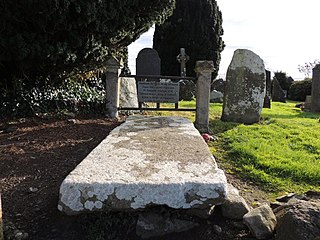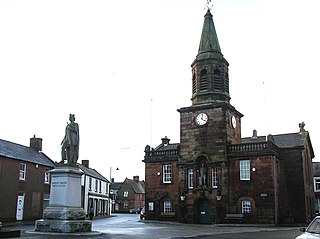
Robert I, popularly known as Robert the Bruce, was King of Scots from 1306 to his death in 1329. One of the most renowned warriors of his generation, Robert eventually led Scotland during the First War of Scottish Independence against England. He fought successfully during his reign to regain Scotland's place as an independent kingdom and is now revered in Scotland as a national hero.

Edward Bruce, Earl of Carrick, was a younger brother of Robert the Bruce, King of Scots. He supported his brother in the 1306-1314 struggle for the Scottish crown, then pursued his own claims in Ireland. Proclaimed High King of Ireland in 1315 and crowned in 1316, he was eventually defeated and killed by Anglo-Irish forces of the Lordship of Ireland at the Battle of Faughart in County Louth.
When the crown of Scotland became vacant in September 1290 on the death of the seven-year-old child Queen Margaret, 13 claimants to the throne came forward. Those with the most credible claims were John Balliol, Robert Bruce, John Hastings and Floris V, Count of Holland.

The First War of Scottish Independence was the first of a series of wars between English and Scottish forces. It lasted from the English invasion of Scotland in 1296 until the de jure restoration of Scottish independence with the Treaty of Edinburgh–Northampton in 1328. De facto independence was established in 1314 at the Battle of Bannockburn. The wars were caused by English kings attempting to establish their authority over Scotland while Scots fought to keep English rule and authority out of Scotland.

Lochmaben is a small town and civil parish in Scotland, and site of a castle. It lies 4 miles (6 km) west of Lockerbie, in Dumfries and Galloway.
Robert de Brus, 6th Lord of Annandale, jure uxoris Earl of Carrick (1252–1292), Lord of Hartness, Writtle and Hatfield Broad Oak, was a cross-border lord, and participant of the Second Barons' War, Ninth Crusade, Welsh Wars, and First War of Scottish Independence, as well as father to the future king of Scotland Robert the Bruce.

Robert V de Brus, 5th Lord of Annandale, was a feudal lord, justice and constable of Scotland and England, a regent of Scotland, and a competitor for the Scottish throne in 1290/92 in the Great Cause. He is commonly known as "Robert the Competitor". His grandson Robert the Bruce eventually became King of Scots.

Clan Bruce is a Lowlands Scottish clan. It was a Royal House in the 14th century, producing two kings of Scotland, and a disputed High King of Ireland, Edward Bruce.

Tibbers Castle is a motte-and-bailey castle overlooking a ford across the River Nith in Dumfries and Galloway, Scotland. To the east is the village of Carronbridge and to the north west is a 16th-century country house, Drumlanrig Castle.
Cupar Castle was a royal castle at Cupar, Fife, Scotland. It was located on a small hill or motte that is known as Castle Hill next to Castlehill Primary School in Cupar. No vestiges of the castle remain above ground.

Sir John Menteith of Ruskie and Knapdale was a Scottish nobleman during the Wars of Scottish Independence. He is known for his capture of Sir William Wallace in 1305 and later joined with King Robert I of Scotland and received large land grants in Knapdale and Kintyre for his service. He is described as "guardian" of the Earldom of Menteith, as his great-nephew Alan II, Earl of Menteith was a minor at the time of the death of Alan I, Earl of Menteith.
Dundee Castle was a castle in Dundee, Scotland, destroyed by Robert the Bruce in 1313.
Wigtown Castle was a royal castle that was located on the banks of the River Bladnoch, south of Wigtown in Dumfries and Galloway, Scotland.
Lochmaben Castle was a 12th-century castle on the spit of land between Loch Kirk and Loch Castle, in Lochmaben, Scotland.
Sir Christopher Seton (1278–1306), also known as Christopher de Seton, was a 13th-century noble, who held lands in England and Scotland. He was a supporter of Robert the Bruce and obtained Robert's sister's hand in marriage. Present during the killing of John Comyn, Lord of Badenoch at Greyfriars Church, Dumfries, he also killed Sir Robert Comyn, who had rushed to Badenoch's aid. Seton was captured at Loch Doon Castle and executed at Dumfries in 1306.
Events from the year 1306 in the Kingdom of Scotland.

Richard Siward, Lord of Kellie, was a 13th-14th century Scottish noble. He was the son of the English adventurer Richard Siward and his wife, the wealthy heiress and widow Philippa Basset countess of Warwick, who had married in 1230. His parents divorced in 1242 and young Richard remained in the custody of his father by the terms of the settlement. The Siwards moved north to Scotland after this, where King Alexander II offered the elder Richard a place in his household and gifts of land in Fife, including Kellie and lands in Aberdour. On his death in 1248 the young Richard remained in Scotland, presumably as a royal ward. He inherited no share of his mother's lands.
Sir John de Seton was a knight who took part in the War of Scottish Independence, as a supporter of Robert de Brus. He held lands in England and Scotland.
Dalswinton Castle, also known as Comyn's Castle, was a castle that was located to the south-east of Dalswinton, in Dumfries and Galloway, Scotland.
Sir Alexander Scrymgeour was a Scottish knight who took part in the War of Scottish Independence, as a supporter of Robert de Brus. He was constable of Dundee and Scottish standard bearer who was captured and later executed by the English in 1306.









